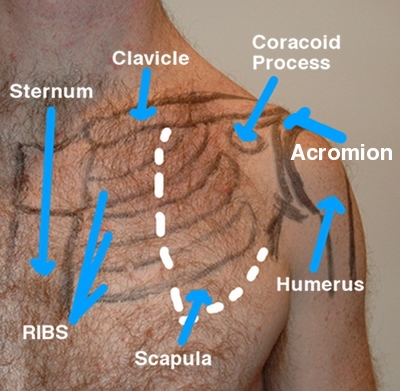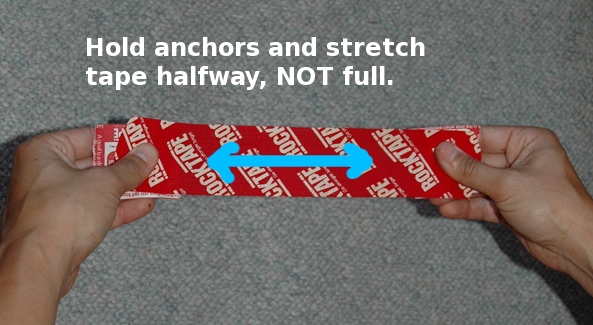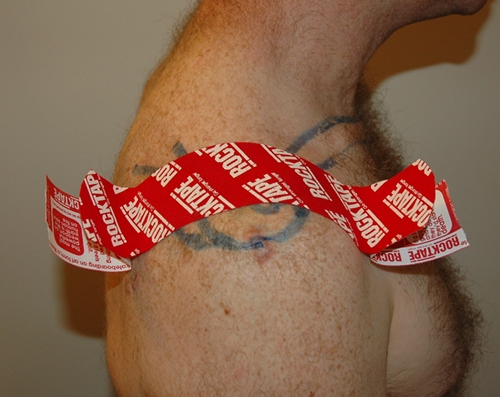AC joint
As you may recall from our intro post on kinesiology taping, we’re going to focus on each muscle group/joint and show you how to use kinesiology tape in three distinct ways:
- Immediately after injury (for swelling and pain)
- During the healing process (correction techniques to restore normal position and allow for healing)
- Techniques to help improve strength + function
In this post, we’ re going to be talking about a taping application for the AC or acromio-clavicular joint. This joint lies on top of the shoulder and is where the clavicle (collar bone) attaches to the scapula. In the case of a “separated shoulder” this attachment is injured and those two bones are able to come apart. Depending on the severity of this injury, the clavicle may actually pop up due to ligament damage. The purpose of this tape application is to hold the bones together to allow the supporting structures to heal.
Anatomy

In your reading, you may have heard of something called the “shoulder girdle”. This is composed of three bones: the scapula, the clavicle, and the humerus. The scapula lays on the back of the rib cage (it is held in place by muscle) and connects to the clavicle/collar bone which wraps around from your breast bone/sternum. These two bones meet on the outside of the shoulder at the acromion (this is the bony bump on the outside of your shoulder). Just beneath the acromion is where the humerus (upper arm bone) attaches to the shoulder blade (the ball or head of the humerus connects to a socket in the scapula known as the glenohumeral fossa). Part of the reason it is referred to as the shoulder girdle versus simply the shoulder joint is because there are actually three joints- 1) where the scapula and the clavicle/collar bone meet at the acromion (this is your AC joint), 2) the glenohumeral joint where the humerus connects to the scapula, and 3) the sternoclavicular or SC Joint where the clavicle attaches to front of the rib cage at the sternum.
To find the AC joint, start by placing your fingers on your collar bone (clavicle). Trace this bone out towards your shoulder. You will notice that as you do so the bone curves back and then finishes with a small bump at the end. You can also trace the scapula forward to the acromion. If you’ve injured the AC joint, pressing down on the end of the clavicle will be uncomfortable. In the case of a severe AC injury, the end of the clavicle may actually be elevated and sticking up.
You can read more about the anatomy in this area and find palpation tips here.
What you will need:
1) Roll of kinesiology tape.
2) Sharpest scissors in the house.
Prep work:
1) Clean skin. This means no oils or lotions of any kind. You want your skin to be clean and more importantly dry. Moisture of any kind = tape will fall off or fail to stick altogether.
2) Hair care. Ideally, the less hair the better. Guys, this means that for best results you will need to trim any long leg hair or shave the calf area.
3) If clean, dry, and hairless skin still = no sticking of tape. Time to get some adhesive spray like Tuf Skin.
4) The tape should last 3-5 days. You can get it wet and shower with it on. Just towel dry it after. No hair dryer! The tape is heat activated.
Taping Techniques
1) AC joint mechanical correction strip
Key Points:
- Prep the skin first. For this application you will want to be seated and sitting up straight with good posture. No slouching! Let the arm rest comfortably at your side.
- Cut the tape so that it is long enough to cover the top of the shoulder (front to back) with 1-2″ of tape on either side (these are your anchors and must be applied without stretch). Round the edges to keep the tape from curling up on the ends or catching on your clothes.
- For this application you will want to apply 50-75% stretch to the tape. You want to hold that stretch and apply it down onto the AC joint. The goal here is to hold the two bones together and keep the clavicle in place!! Don’t sweat the 50-75%. Think medium stretch versus maximum “how far can I pull this tape” kind of stretch. Hold the anchors, stretch the tape and then with that same stretch, push the tape down over the AC joint.
- Once the tape is applied, remove the paper backing from the anchors and then simply lay the ends down. Rub the tape to warm up the adhesive. Here is what the finished application looks like:
- For further instructions on how to incorporate kinesiology taping into your self treatment regimen click here.
References
1) Capobianco, Dr. Steven and van den Dries, Greg. (2009). Power Taping, 2nd Edition, Rock Tape Inc, Los Gatos, CA.
2) Hammer, Warren. (2007). Functional Soft-Tissue Examination and Treatment by Manual Methods, 3rd edition. Jones and Bartlett Publishers, Inc, Sudbury, MA.
3) Kase, Kenzo, Wallis, Jim, and Kase, Tsuyoshi. (2003). Clinical Therapeutic Applications of the Kinesio Taping Method.
4) Muscolino, Joseph. (2009). The Muscle and Bone Palpation Manual. Mosby, Inc, St. Louis, MO.
















